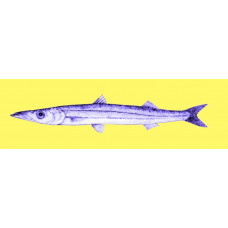Latin name
Sphyraena helleri
Other name
Sphyraena helleri
Identification
This species is characterised by the following set of features: first gill arch with a single gill blade; lateral line scales 121-127 pores, total number of lateral line scales 132-134; scales above lateral line 12-13 and below 14-15; snout relatively broad, its length 15.0-16.4% of body length; maxilla long, posterior tip reaching to or above anterior nostril but not below posterior nostril, its length 11.9-12. 9% of body length; eye large, orbital diameter 4.8-5.9% SL and depth 4.8-5.6% SL; posterior canal located relatively close to beginning of anal fin, its anterior and posterior margins 6.5-8.2% HL and 4.1-4.9% HL, respectively; sensory canal pores of head in suborbital region simple or sometimes slightly branched, their lower parts located very close to margin of lacrimal bone, large smooth area without canal pores absent at middle margin of lacrimal bone.
Features of fish fins
Dorsal spines (total): 6; Dorsal soft rays (total): 9; Anal spines: 2; Anal soft rays: 8 - 9.
The pelvic fin is slightly upright from the beginning of the first dorsal fin. The length of the last ray of the dorsal and anal fins is 4.2-4.3% SL and 3.6-4.7% SL respectively, the base of the anal fin is somewhat short with a length of 6.8-7.5% SL.
Fish colouring
The body of the Heller's barracuda is silvery with no stripes on the sides. The caudal fin is grey.
Distribution
This species is found in the Indian Ocean (East Africa and the Mascarene Islands) and the Pacific Ocean (north to southern Japan, south to the Coral Sea and east to French Polynesia; Hawaiian Islands).
Habitat
Subtropical marine species, depth range 10-104 m. These fish inhabit coral reefs and bays.
Size
Heller's barracuda can reach a length of 40-80 centimetres. Maximum declared weight: 1.8 kg.
Behavior
Heller's barracudas are primarily nocturnal. They are usually seen in large schools during the day and hunt at night.
Food and feeding habits
Feeds mainly on a variety of schooling fish, which it actively pursues or hunts from ambush. Sometimes several individuals are involved in the hunt. Cephalopods and crustaceans are also recorded in the diet.
Reproduction
These fish reach maturity early. They spawn at the surface. This predator can reproduce all year round. Almost immediately after emergence, these small fish go on the hunt. As the juveniles develop and grow, they move into deep water on their own. Very often the children become victims of their parents. The males attract the attention of the females by organising fierce and bloody fights.
Fishing
This species is commercially important for fishing.
Relationship with a person
Harmless. Not recommended for consumption due to poisonous liver, roe and milt.
| Classification | |
| Phylum | Chordata |
| Class | Actinopterygii |
| Squad | Carangiformes |
| Family | Sphyraenidae |
| Genus | Sphyraena |
| Species | S. helleri |
| Features | |
| Conservation status | Not Evaluated |
| Habitat | Pelagic |
| Life span, years | No information |
| Maximum body weight, kg | 1,8 |
| Maximum length, cm | 80 |
| Sailing speed, m/s | No information |
| Threat to people | Edible |
| Way of eating | Predator |
Heller's barracuda
Tags: heller's barracuda


